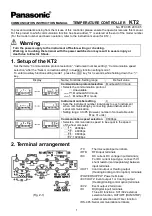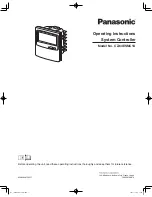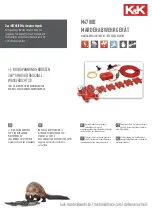
6
7
Always route low voltage (sensor) signals with at least a 6” (15 cm) separation from AC voltage wiring.
The
electrodeless conductivity sensor
should be placed as close to the controller as possible, to a maximum distance
of 120 ft. (37 m). Less than 20 ft. (6 m) is recommended.. The cable must be shielded from background electrical noise.
Always route low voltage (sensor) signals with at least a 6” (15 cm) separation from AC voltage wiring. These sensors
are affected by the geometry and conductivity of their surroundings, so either maintain 6 inches (15 cm) of sample
around the sensor or ensure that any nearby conductive or nonconductive items are consistently positioned. Do not install
the sensor in the path of any electrical current that may be flowing in the solution, as this will shift the conductivity reading.
IMPORTANT:
To avoid damaging the female pipe threads on the supplied plumbing parts, use no more than 3 wraps
of PTFE tape and thread into the pipe FINGER tight only! DO NOT use any pipe dope, plumber’s putty or other
sealing products that containdiacetone alcohol, as these attack the flow switch plastic! Use PTFE tape ONLY!
Boilers:
The
conductivity sensor
should be placed as close to the controller as possible, to a maximum distance of 250 ft.
(76m). The cable MUST be shielded from background electrical noise. Use 24 AWG cable.
Important Boiler Installation Notes: (see figures 3 and 4)
1. Make sure the minimum water level in the boiler is at least 4-6 inches (10-15 cm) above the skimmer blowdown
line. If the skimmer line is closer to the surface, it is likely that steam will be drawn into the line instead of boiler
water. The skimmer line must also be installed above the highest tube.
2.
Maintain a 3/4 inch minimum pipe ID with no flow restrictions from the tap for the boiler skimmer blowdown
line to the electrode. If the ID is reduced below 3/4 inch, then flashing will occur beyond that point and the con
-
ductivity reading will be low and erratic. Minimize the usage of tees, valves, elbows or unions between the boiler
and the electrode.
3. A manual shut off valve should be installed so that the electrode can be removed and cleaned. This valve must be
a full port valve in order to avoid a flow restriction.
4. Keep the distance between the tap for the boiler skimmer line to the electrode as short as possible, to a maximum
of 10 feet (3m).
5. Mount the electrode in the side branch of a tee in a horizontal run of pipe. This will minimize entrapment of
steam around the electrode and will allow any solids to pass through.
6.
There MUST be a flow restriction after the electrode and/or control valve in order to provide back pressure. This
flow restriction will be either a flow control valve or an orifice union. The amount of the flow restriction will
affect the blowdown rate as well, and should be sized accordingly.
7. Install the motorized ball valve or solenoid valve per the manufacturer’s instructions.
For best results, align the hole in the conductivity electrode such that the direction of water flow is through the hole.
Guide to Sizing Blowdown Valves and Orifice Plates
1. Determine the Rate of Steam Production in Pounds per Hour:
Either read off the boiler name plate (water-tube boilers) or Calculate from horsepower rating (fire-tube boilers):
HP x 34.5 = lbs./hr. Example: 100 HP = 3450 lbs./hr
2. Determine the Concentration Ratio (BASED ON FEEDWATER)
A water treatment chemical specialist should determine the desired number of cycles of concentration. This is the
ratio of TDS in the boiler water to TDS in the feedwater. Note that feedwater means the water that is fed to the
boiler from the deaerator and includes makeup water plus condensate return.
Example: 10 cycles of concentration has been recommended
3. Determine the Required Blowdown Rate in Pounds Per Hour
Blowdown Rate = Steam Production / (Concentration Ratio –1)
4 mA Value
0
30,000
20 mA Value
0
30,000
Hand Output
0%
100%
Set Point
0
30,000
Proportional Band
0
30,000
Minimum Output
0%
100%
Maximum Output
0%
100%
Off Mode Output (Proportional, PID, Flow Prop modes)
0 mA
21 mA
Pump Capacity (Flow Prop mode)
0 gal/hour or l/hour
10,000 gal/hour or l/hour
Pump Setting (Flow Prop mode)
0%
100%
Specific Gravity (Flow Prop mode)
0 g/ml
9.999 g/ml
Target (Flow Prop mode)
0 ppm
1,000,000 pm
Error Output
0 mA
21 mA
Configuration settings
Low Limit
High Limit
Local Password
0000
9999
Alarm Delay
0:00 minutes
59:59 minutes
3.0 UNPACKING & INSTALLATION
3.1 Unpacking the unit
Inspect the contents of the carton. Please notify the carrier immediately if there are any signs of damage to the
controller or its parts. Contact your distributor if any of the parts are missing. The carton should contain a W100
series controller and an instruction manual. Any options or accessories will be incorporated as ordered.
3.2 Mounting the electronic enclosure
The controller is supplied with mounting holes on the enclosure. It should be wall mounted with the display at eye level,
on a vibration-free surface, utilizing all four mounting holes for maximum stability. Use M6 (1/4” diameter) fasteners
that are appropriate for the substrate material of the wall. The enclosure is NEMA 4X (IP65) rated. The maximum
operating ambient temperature is 131°F (55°C); this should be considered if installation is in a high temperature
location. The enclosure requires the following clearances:
Top:
2” (50 mm)
Left:
8” (203 mm) (not applicable for prewired models)
Right:
4” (102 mm)
Bottom:
7” (178 mm)
3.3 Installation
Once the controller is mounted, the metering pumps may be located at any distance from the controller.
Plumbing
The W100 se
ries controllers can be supplied with a flow switch manifold designed to provide a continuously flowing
sample of cooling water to the sensors. Please refer to Figures 2 through 6 below for some typical installation drawings.
Cooling Towers:
Tap off the discharge side of the recirculation pump to provide a minimum flow of 1 gallon per minute past the sensor.
The sample must flow into the bottom of the manifold in order to close the flow switch, and return to a point of
lower pressure in order to ensure flow. Install an isolation valve on both sides of the manifold to stop flow for
sensor maintenance.
The
contacting conductivity sensor
should be placed as close to the controller as possible, to a maximum distance of
250 ft. (76 m). Less than 25 ft. (8 m) is recommended. The cable must be shielded from background electrical noise.







































